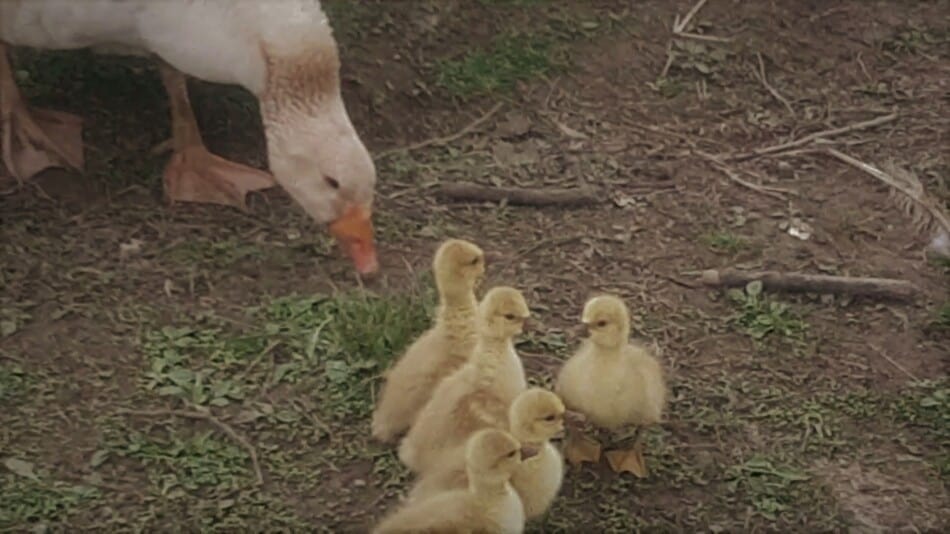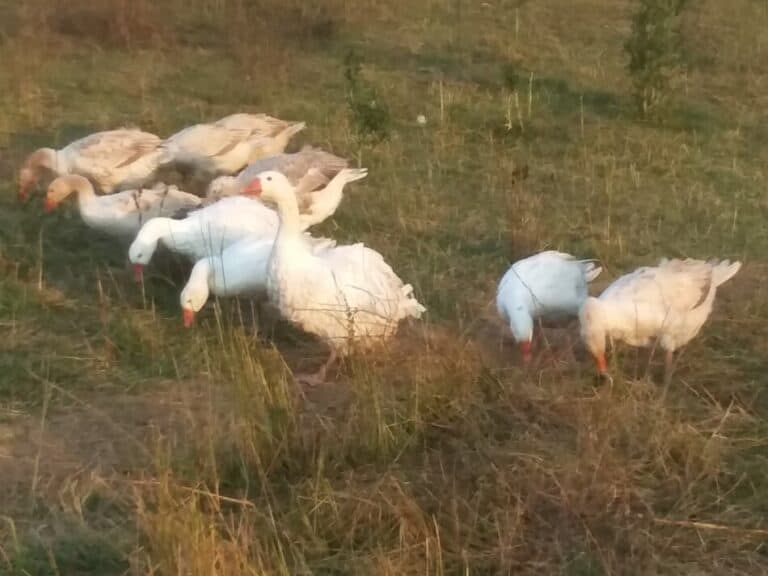How Much Space Do You Need To Raise Geese?

Small flock geese are making a comeback, and for good reason! Geese are easy care, adaptable and eat the grass in your yard for most of their food!
How many geese can you have in your yard and how much space do they need to have in their pen?
| Age of geese | Space needed (per goose) | Area needed (minimum per group) |
| 0-3 weeks (in brooder) | 2 sq. ft. each | 10 sq. ft. |
| 4-8 weeks (in brooder until fully feathered) | 6 sq. ft. each | 32 sq. ft. |
| 9-16 weeks (grow out period for market geese) | 7 sq. ft. each | 40 sq. ft. |
| 17+ weeks (breeder geese) | 8 sq. ft. each | 48 sq. ft. |
| Pasture (high quality) | 725 sq. ft. each | 60 per acre, market geese |
| Pasture (poor quality) | 2,178 sq. ft. each | 20 adult geese per acre |
| Pasture (good quality) | 1,089 sq. ft. each | 40 adult geese per acre |
| Backyard (year round) | 1/4 acre per pair | 1/4 acre per pair |
Is Raising Geese Worth It? is my article giving all of the costs you’ll need to consider when raising your geese, breeding stock included.
Goslings 0-3 weeks need 2 sq. ft. of space each
Your goslings will need to have 2 sq. ft. of space per bird for the first three weeks of being in the brooder.
Goslings need to be in a brooder for the first 8 weeks or so, or until they are fully feathered.
A brooder is a heated area you keep young poultry in until the birds are old enough to be in an outside pen without supplemental heat.
Really, the brooder is just making up for the care their mom would provide for them when they are young.
There is a minimum sq. ft. per group of goslings
You’ll notice the table above shows space needed per gosling then a minimum space per group. Let me explain.
The importance of the area needed per group is for anyone with a small number of geese.
Let’s say you have 3 geese. When they are 0-3 weeks old, they need 2 sq. ft. each of pen space, which would be a total of 6 sq. ft. But…
You’ll need to make the pen area 10 sq. ft. just to give them more room to move around and to keep the pen comfortable for them.
Less than 10 sq. ft. will have them with a messy pen in no time!
If you have more than 5 or so geese, you’ll always end up above the group area minimum when you figure up the size of the pen you need.

At 4-8 weeks, goslings need 6 sq. ft. each
When your goslings are 4-8 weeks old, they need 6 sq. ft. of pen space each with a total pen minimum area of 32 sq. ft.
You’ll want to give them more room to roam, so it will be easier to keep their pen and the goslings, clean.
Crowding the goslings into a smaller space will make them get messy much more quickly than if they are given ample room.
By this age, you will have noticed that goslings, like all waterfowl, are water guzzlers.
By giving them a bigger pen, you keep the water mess to one spot and keep the rest of the pen dry.
Your goslings are now old enough to toddle around and check out the rest of their brooder area.
The more space you can give them, the happier they will be.
Are Geese Easy To Raise? gives you the highlights of raising geese.
4-8 week old goslings still need heat
Even though they are getting bigger now, they still need the extra heat for a few weeks yet, until they have all of their feathers.
However, you should be reducing the heat in the brooder by 5 degrees every week, starting at 90 when they first arrive as hatchlings.
By reducing the heat every week, you’ll acclimate them to the ambient temperatures so they can be put in a pen without the extra heat.
We do this by lowering the temperature by 5 degrees every week until the temperature in the brooder is about the low temperature for the day.
This usually happens at around 6 weeks, but it really depends on the temps in your area. Don’t hesitate to turn the heat back on at night, if they need it.
The easy way to lower the brooder temperature is to turn off one of the lights (only if you have multiple lights) or raise up the light.
We do which ever makes the most sense or a combination of both.
At 9-16 weeks, geese need 7 sq. ft. each
If you are planning on putting your geese outside, now is the time. Actually, anytime after they stopped needing the supplemental heat would work.
Your geese do not need to go outside, if a pen is a safer environment for them, keep them in for a while longer.
However, they will really up the pooping, so putting them where the poop is wanted seems like a good thing to me!
Looking at the table above, you’ll notice that you can have 60 geese per acre when you are grazing geese of this size.
You should also note that 60 geese per acre is with high quality grass, alfalfa and or clover available. Poor quality pastures will need to have less geese.
If 60 geese per acre sounds like too many for your yard, consider that it is 15 geese per quarter acre area or 30 per half acre of grazing for market geese.
17+ weeks, geese need 8 sq. ft. each
Now that the goslings are 17+ weeks old, we are into the breeding stock geese, or at least geese that you are keeping around for a while.
If you were raising market geese, you have probably had them processed by now, or it’s getting really close.
Your geese will need 8 sq. ft. each with a minimum of 48 sq. ft. Even if you are keeping just a pair of geese, you still need to give them 48 sq. ft.
This is not a big area, a piece of plywood is 64 sq. ft. (8×8) so don’t skimp here.
Shorting them on space will give you problems with nesting, as in you going in to feed them and the geese feeling you are too close to the nest.
Give them the extra space.
For breeding stock geese on pasture, the stocking rates are different than the rates listed above for the market geese.
Adult geese need to be kept at 20-40 per acre, more on the better pastures, of course.
The reason for this is that you are likely to be supplementing the market geese with feed of some sort, whereas the adults are mostly on their own until egg laying season, which would be inside anyway.
Our geese roam about in a flock and go out to graze every day, on their own.
They will make it out to grass in nearly any weather then come back to the barnyard for the night.
Now that we are getting to nesting season, they are spending more time in the barn, deciding who gets to stay where for the spring nesting areas.
Have 1/4 acre per pair of adult geese
PoultryKeeper.com suggests keeping a pair of adult geese on one quarter acre of yard.
The grass needs to be kept at about 3 inches, so it does not get ahead of the geese and stays tender.
We never mow our yard, the sheep eat the first round of grass in the spring, it grows too fast for the geese to keep up with it, then the geese keep it down after that.
Have a simple shelter for your goose pair
You should also consider having a 4×5 shed for the geese to go into at night.
This gives them a safe place to go for the evening and a nice dry place to make a nest.
Your pair of geese will require some supplemental feeding in the winter, since winter grass is not as high quality as the summer grass.
This is easily done with corn or wheat and, of course, plenty of fresh water.
Resources:
Metzer Farms, How Much Space Should I Have For My Ducks And Geese?
Raising Geese In Small Or Backyard Flocks, University of Missouri Extension


